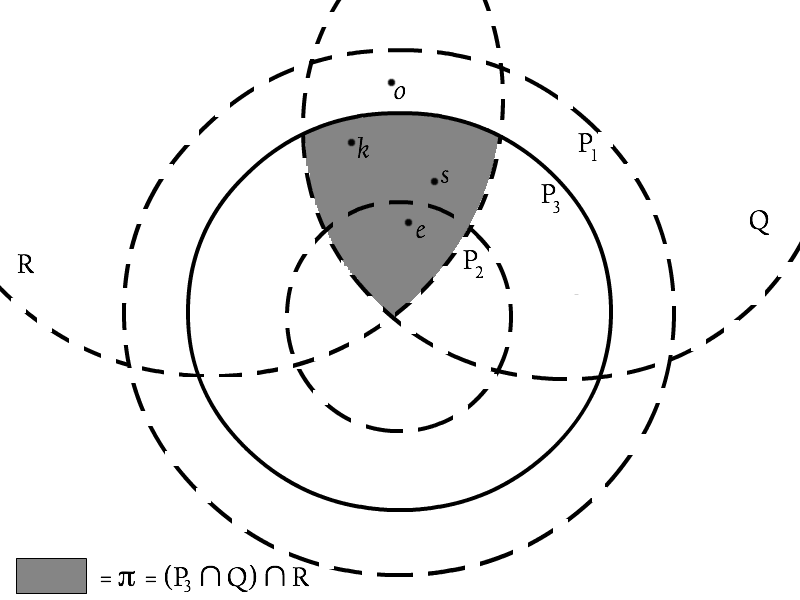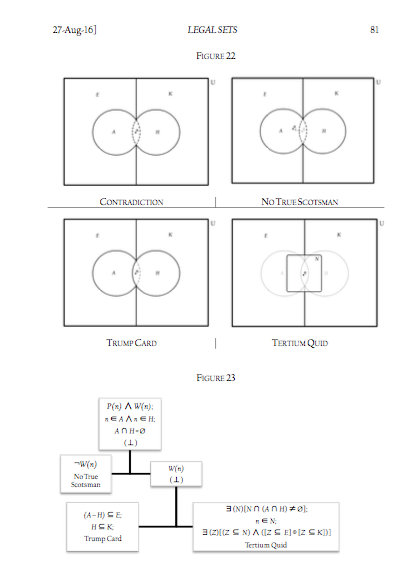This is a point that is probably too big for a blog post. But as the end of the Supreme Court term rolls around, and we start getting decisions in some of the more divisive cases of our times, something about the political undercurrents of the Court’s annual ritual has me thinking about the way it tends to legalize morality, and how much of our political narrative has to do with our disagreement about the way morals and law interact. I’m not speaking here about the positivist vs. anti-positivist debate in jurisprudence, which I view as being primarily about the ontology of law: what makes law “law” instead of something else. That question holds fairly little interest for me. Instead, I’m interested in the debate underlying that question: about the relationship between law on the one hand and justice or morality on the other. Most of the political energy released over these late decision days is not, I think, about the law, nor even about the morality, of the disputes themselves. Instead, it seems to me to be about the extent to which moral obligations ought or ought not to be legal ones–particularly in a democratic country whose citizens hold to diverse moral systems.
There is a long philosophical tradition that holds there is a difference between the kinds of conduct that can be enforced by legal coercion and the kinds that may attract moral praise or blame but which the state has no role in enforcing. This distinction–between the strict or “perfect” duties of Justice (or Right) and the softer or “imperfect” duties of Virtue (or Ethics)–is most familiar from Kant’s moral philosophy, but it has precursors stretching from Cicero to Grotius. Whether or not the distinction is philosophically sound or useful, I think it is a helpful tool for examining the interaction of morals and laws–but not in the sense in which philosophers have traditionally examined them. For most moral philosophers, justice and virtue are complementary parts of a cohesive whole: a moral system in which some duties are absolute and others contingent; the latter must often be weighed (sometimes against one another) in particular circumstances, but all duties are part of a single overarching normative system. But I think the end of the Supreme Court term generates so much heat precisely because it exposes the friction between two distinct and sometimes incompatible normative systems: the system of legal obligation and the system of moral obligation.
The simplest world would be one in which the law required us to do everything that was morally obligatory on us, forbade us to do everything that was morally wrong, and permitted us to do everything morally neutral–where law and morality perfectly overlap. But that has never been the world we live in–and not only because different people might have different views about morality. Conflicts between law and morality are familiar, and have been identified and examined at length in the scholarly literature, sometimes in exploring the moral legitimacy of legal authority, other times in evaluating the duty (or lack thereof) of obeying (or violating) unjust laws. Such conflicts are at least as old as Socrates’ cup of hemlock; one can trace a line from Finnis back to Aquinas, and from Hart back to Hobbes. Moreover, because in our society moral obligations are often derived from religious convictions, and our Constitution and statutes give religious practices a privileged status under the law, these conflicts are quite familiar to us in the form of claims for religious exemption from generally applicable laws–historically in the context of conscientious objection to military service, and more recently as an expanding web of recurring issues under the Religious Freedom Restoration Act.
But religious convictions are not the only moral convictions that might conflict with legal obligations. And the question whether one ought to obey an unjust law represents only one type of intersection between the two normative systems of law and morals–the most dramatic one, certainly, and the one that has garnered the most attention–but not the only one. Some of those intersections will present a conflict between law and morality, but many will not. Still, I think each such intersection carries a recognizable political valence in American society, precisely because our political allegiances tend to be informed by our moral commitments. I’ve outlined a (very preliminary) attempt to categorize those political valences in the chart below, though your views on the categories may differ (in which case I’d love to hear about it):
Political Valence
|
Moral Categories |
| Wrong |
Suberogatory |
Morally Neutral |
Right |
Supererogatory |
| Legal Categories |
Forbidden |
Law and Order |
Nanny State |
Victimless Crime |
Civil Disobedience |
| Permitted |
Failure of Justice |
The Price of Liberty |
The Right to be Let Alone |
Good Deeds |
Saints and Heroes |
| Required |
Just Following Orders |
Red Tape |
Civic Duty |
Overdemanding Laws |
Now of course, people of different political stripes will put different legal and moral situations into different boxes in the above chart, and frame the intersection of law and morals from the points of view of different agents. In our current political debate over enforcement of the immigration laws, for example, an American conservative might frame the issue from the point of view of the immigrant, and put enforcement in the “Law and Order” box; while an American progressive might frame the issue from the point of view of federal agents, and put enforcement in the “Just Following Orders” box. Conversely, to the progressive, the “Law and Order” category might call to mind the current controversy over whether a sitting president can be indicted; to a conservative, the “Just Following Orders” category might call to mind strict environmental regulations. Coordination of health insurance markets through federal law might be seen as an example of the Nanny State (conservative) or of Civic Duty (progressive–though 25 years ago this was a conservative position); permissive firearms laws as either a Failure of Justice (progressive) or as part of the Right to be Let Alone (conservative).
The complexity of these interactions of law and morality strikes me as extremely important to the functioning of a democratic, pluralistic society committed to the rule of law. On the one hand, the coexistence of diverse and mutually incompatible moral systems with a single (federalism aside) legal system means that inevitably some people subject to the legal system will identify some aspects of the law with a negative political valence while other people subject to the same legal system will identify those same aspects of the law with a positive political valence. For a society like ours to function, most of these people must in most circumstances be prepared to translate their moral dispute into a political-legal dispute: to recognize the legitimacy of law’s requirements and channel their moral disagreement into the democratic political process of changing the law (rather than making their moral commitment a law unto itself). The types of political valences I’ve identified may be a vehicle for doing precisely that: they provide a narrative and a framework that focuses moral commitments on political processes with legal outcomes. Our political process thus becomes the intermediating institution of our moral conflicts.
These types of moral disagreements are likely to account for the vast majority of disagreements about which political valence is implicated in a particular legal dispute. But interestingly, I think it is also likely that some disagreements over the political valence at the intersection of a legal and a moral category could arise even where people are in moral agreement. In such cases, the right/wrong axis of moral deliberation is replaced with the right/no-right axis of Hohfeldian legal architecture: we agree on what the parties morally ought to do, and the only question is how the law ought to be structured to reflect that moral agreement. Yesterday’s opinion in the Masterpiece Cakeshop case strikes me as evidence of this possibility, and I’m unsure whether that makes it comforting or concerning.
To be sure, there are deep moral disagreements fueling this litigation. The appellants and their supporters believe as a matter of sincere religious conviction that celebrating any same-sex marriages is morally wrong, and that it is at least supererogatory and perhaps morally required to refrain from contributing their services to the celebration of such a marriage. The respondents and their supporters believe that celebrating loving same-sex marriages is at least morally neutral and more likely morally right, and that refusing to do so is at least suberogatory and more likely morally wrong. (Full disclosure: I’m soundly on the side of the respondents on this moral issue.) But that moral dispute is not addressed in the opinion that issued yesterday. The opinion resolves a legal question–the question whether Colorado’s anti-discrimination laws had been applied in a way that was inconsistent with the appellants’ First Amendment rights. And the Court’s ruling turned on peculiarities of how the Colorado agency charged with enforcing the state’s antidiscrimination law went about its business–particularly, statements that Justice Kennedy believed evince “hostility” to religious claims.
It is quite likely that both political progressives and political conservatives would agree that “hostility” to religious beliefs on the part of state law enforcement officials is morally wrong, or at least suberogatory. And if that–rather than the morality of celebrating same-sex marriages–is the real moral issue in the case, the parties’ deep moral disagreement moves to one side, and instead we must simply ask how the law ought to be fashioned to avoid the moral wrong of anti-religious hostility. Here, interestingly, the typical moral progressive/conservative battle lines are either unclear or absent. If you agree with Justice Kennedy’s characterization of the facts (which you might not, and which I do not), and if you believe the respondents lack the power to compel the appellants to provide their services in connection with same-sex wedding celebrations (or that they ought to lack this power), you likely believe that the case so framed is a vindication of law and order. But even if you think the respondents do (or should) have the power to compel the appellants to provide their services for same-sex weddings, and you agree with Justice Kennedy’s characterization of the facts, invalidating this otherwise permissible state action on grounds that it was motivated by morally suspect “hostility” might be acceptable so framed as a vindication of Law and Order, or at worst seen as an example of the Nanny State. And this reveals an important point that I think likely motivated the Justices in Masterpiece Cakeshop: with this resolution of the case there is a way for moral adversaries to agree on the political valence of the outcome.
There is obviously no guarantee that the litigants or their supporters will come to such agreement. To the contrary, it seems more likely that both parties’ supporters will see the “hostility” reasoning as a distraction from the outcome, which still touches on the deeper moral issues involved: the appellants’ supporters will see the outcome as a vindication of Law and Order and an invitation to Good Deeds, while respondents’ supporters will see it as a Failure of Justice and an instruction to state law enforcement agents to Just Follow Orders. But at the very least, political agreement is possible in a way that it would not be if the Court had aligned the law with one of the conflicting moral frameworks of the litigants and against the other.
It is both the virtue and the weakness of this type of solution is that it solves a legal controversy without taking sides in the moral disputes that ultimately generated the controversy in the first place. In so doing, it insulates the law from contests of morality and, possibly, of politics–but those contests haven’t gone away. Conversely, such solutions might have the effect of insulating politics from law: if the courts will only decide disputes on grounds orthogonal to the moral commitments underlying political movements, such movements may cease to see the law as a useful instrument, and may start casting about for others. I’m not sure that’s a healthy result for a society trying to hold on to democracy, pluralism, and the rule of law all at the same time. On the other hand, I’m not sure there’s a better option. The belief that we can, and somehow will, forge a common legal and political culture despite our deep moral disagreements is not one I think a republic can safely abandon.


